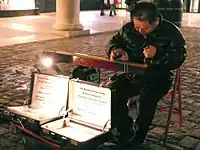Duxianqin
The duxianqin is a Chinese plucked string instrument with only one string; it is nearly identical to the Vietnamese đàn bầu, from which it likely was derived. Chinese sources describe độc huyền cầm as being an instrument of the Jing (also spelled Gin or Kinh) ethnic group, who are ethnic Vietnamese living in China.[1] It is still sometimes played by these ethnic groups. Sometimes the body of the instrument is made from a large tube of bamboo rather than wood, which is more common in Vietnam.


| Duxianqin | |||||||||
|---|---|---|---|---|---|---|---|---|---|
| Traditional Chinese | 獨弦琴 | ||||||||
| Simplified Chinese | 独弦琴 | ||||||||
| Literal meaning | "lone string zither" | ||||||||
| |||||||||
| Alternative Chinese name | |||||||||
| Chinese | 一弦琴 | ||||||||
| Literal meaning | "one string zither" | ||||||||
| |||||||||
Cultural context
The duxianqin has been recognized by the Chinese government to be "a vehicle of 'intangible cultural heritage,' which can be defined as song, music, dance, drama, crafts and similar prized skills that can be recorded but not touched or interacted with."[2] The cultural significance of duxianqin as a traditional instrument for ethnic groups is commonly accepted and enjoyed within China. It is common for groups of duxianqin players to come together to play at large-scale and small-scale Chinese festivals.
Playing the duxianqin
The duxianqin is played using harmonics, with the string's tension varied by the use of a flexible rod. The string is plucked with the right hand, and the pitch is simultaneously controlled with the left hand by moving the rod to adjust the tension on the string.[2] Depending on the direction that the rod is turned, either toward or away from the player, it will bend the pitch of the string to higher or lower notes.[3]
External links
- Photograph of a duxianqin
- Duxianqin article (Chinese)
- Duxianqin page (Chinese)
See also
- Đàn bầu
- Diddley bow
- Traditional Chinese musical instruments
References
- "Duxianqin". Cultural China. Archived from the original on 4 March 2016. Retrieved 18 September 2014.
- "Across China: Ethnic instrument playing preserved in S China". NewsBank. Xinhua News Agency Economic News (China). 30 July 2014. Retrieved 18 September 2014.
- "Monochord Relatives to the One-String Diddley Bow". suite.io. Archived from the original on 29 August 2015. Retrieved 19 September 2014.

